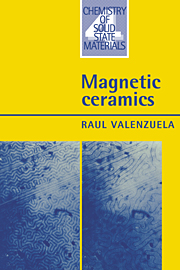1 - Introduction
Published online by Cambridge University Press: 28 October 2009
Summary
We are surrounded by magnetic materials playing a crucial role in many devices of every-day life: ac and dc motors which perform many operations (a top-of-the-range car has more than 20 dc motors); power distribution systems, based on power transformers, which deliver energy for home and industrial use; video and audio applications (tapes, writing/reading heads) which provide information and entertainment on a massive scale; telephone and telecommunication systems (microwave devices) which link continents at nearly the speed of light; data storage systems (discs, disc drives) which pervade virtually every human activity.
The history of magnetic materials is as old as that of man; the strange properties of magnetite (a magnetic ceramic!) have been linked to the military successes of an ancient Chinese Emperor (Huang-Ti, 2600 BC). The word magnet is derived from a Greek word used to indicate magnetite deposits in the district of Magnesia. The first study of magnetism is the book De Magnete, by W. Gilbert, published in 1600. The next significant development in magnetism occurred in 1825, when H. C. Oersted reported the crucial fact that magnetic fields can be produced by means of electrical currents. This discovery opened the way to the first applications of magnetism. Discoveries, models and theories have developed since at an increasingly accelerated pace. An amazing fact is that all the impressive variety of magnetic materials and their properties originate mainly from the three elements that are ferromagnetic at room temperature: iron, cobalt and nickel.
- Type
- Chapter
- Information
- Magnetic Ceramics , pp. 1 - 2Publisher: Cambridge University PressPrint publication year: 1994

